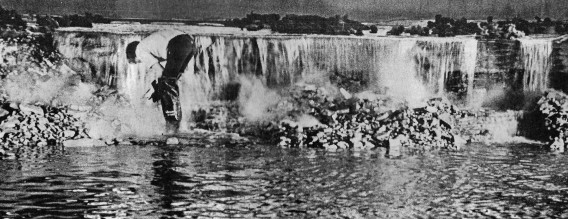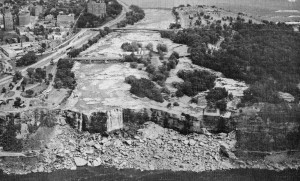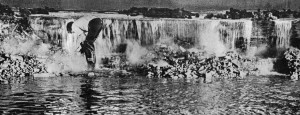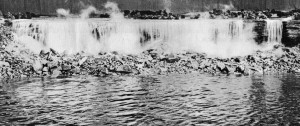- Home
- Niagara Falls Hotels
- Restaurants
- Casinos
- Niagara Falls Shut Off
- Niagara Falls USA
- Aquarium of Niagara Falls
- Goat Island
- Lewiston
- Lockport Caves
- Niagara Falls Cave of the Winds
- Niagara Falls Culinary Institute
- Fashion Outlets of Niagara Falls
- Niagara Falls Observation Tower
- Niagara Falls State Park
- Niagara Fishery
- Niagara Gorge Discovery Center
- Niagara Power Vista
- Maid of the Mist
- Oakwood Cemetery
- Old Fort Niagara
- Rainbow Bridge
- Niagara Falls Canada
- Daredevils
- Links
Niagara Falls News
American Falls Erosion Issue Reviewed 49 Years Ago

In 1967 the International Joint Commission, which was formed in 1910 by both the United States and Canada to oversee problems along the 3000 mile mutual border, began a process to determine what could be done to address the erosion issue with the American Falls. The Commission created The American Falls International Board and two years later that board initiated the famous “de-watering” of the American Falls to allow an up close examination of the problem. However, some 80 miles north a much smaller model of the Falls was created to give geologists and engineers a hands on approach to fixing the problem.
A model which was 1:50th scale of the American Falls was constructed at the Islington laboratory of the Hydro-Electric Power Commission of Ontario near Toronto. The team looked at three kinds of physical change to be made to the American Falls and the cost associated with each change.
The three choices were:
1. To remove the fallen rock from the base of the American Falls. This would require de-watering the American Falls for one or two tourist seasons. The estimated cost: $1 million to $10 million , depending on the amount of debris removed.
2. To increase the flow over the American Falls by excavating rock in the channel leading to the American Falls and installing control gates. This would require de-watering the American Falls for one season. The estimated cost: $6 million.
3. To restore the level of the Maid of the Mist Pool to the earlier condition by building a submerged structure a few miles downstream of the Falls. The estimated cost: $8.7 million.
The commission distributed 220,000 brochures in 1973 with ballots on both sides of the border to obtain a public consensus of what should be done about the talus of the American Falls. The ballots contained the three proposed options for the American Falls and participants were asked to mail their completed ballots to destinations in Burlington Ontario and Buffalo New York.
Two years later, in 1975, the International Joint Commission presented the conclusions reportedly determined by the completed ballots and their own study and made recommendations in a report entitled “Preservation and Enhancement of the American Falls at Niagara. This was their findings:
The talus at the base of the American Falls is estimated by engineers at 358,000 tons (280,000 cubic yards) with the talus reaching 135 feet (41M) high in places reducing the water fall from 100 feet (30m) to a mere 45 feet (13.7M). The depth of the talus ranges from 25 feet (7.6m) to 50 feet (15m).
The talus was accumulated as a result of major rock falls in January 1931, July 1954 and December 1959 which cumulatively deposited approximately 130,000 cubic feet of talus at the base of the American Falls.
During the de-watering process, tests included 46 core borings totaling 4,882 feet (1488m). In addition to various mapping and probing processes, piezometers were installed to measure water pressure on rock joints and extensometers to measure rock movements.
The public response was overwhelming. Five thousand prepaid cards were returned along with 70,000 other replies. The conclusion of this process was that a majority of respondents chose to not change the American Falls.
The International Joint Commission came to five basic conclusions:
- while it is technically feasible to remove the talus which has collected at the base of the American Falls, it is not desirable to do so at the present time
- while structural solutions are available to arrest erosion at the crest of the American Falls, the Falls should not be stabilized by artificial means
- a broad environmental study should be jointly carried out by Canada and the United States to identify and give priority to those measures which best enhance the total setting and beauty of the Niagara Falls area
- that the two flanks of the American Falls and the Goat Island flank of the Horseshoe Falls are sufficiently unstable to warrant remedial action …
- a statistically minor element of risk from unpredictable rock movement will remain and must be accepted by the viewing public.
At the end of the 8 year process no debris or rocks were removed from the base of the American Falls. The face of the gorge that made up the American Falls was reinforced with long metal rods to slow the erosion of the Falls. It was also determined that the reduction of water flow over the American Falls by the International Water Control Dam, which was built in 1954, slowed down the amount of erosion that was occurring with the American Falls.












